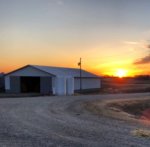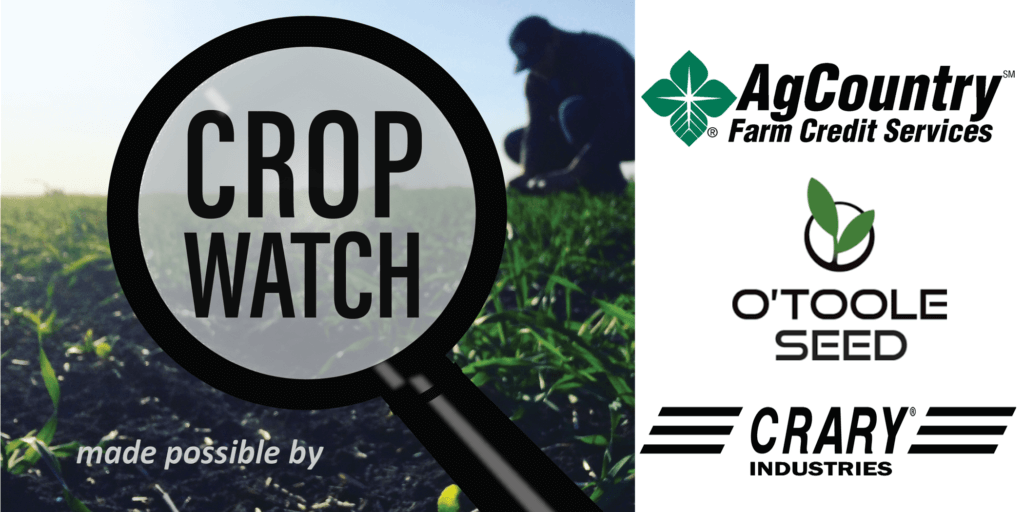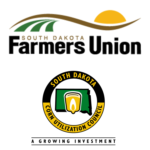
A Weekly Update from the Red River Farm Network
Monday, May 11, 2020
Reporting Agriculture’s Business – Welcome to the latest edition of FarmNetNews. In this issue you’ll find news about COVID-19 and its impact on agriculture, planting progress, market analysis and more. If you know someone who would benefit from this publication, they can sign up online or by emailing don@rrfn.com.

Trump Calls for DOJ Investigation – President Donald Trump has asked the Justice Department to investigate the wide disparity between the cash cattle price and wholesale beef prices. “I asked them to take a serious look into it because it shouldn’t be happening that way and we need to protect our farmers.” At the same White House briefing with reporters Wednesday, Agriculture Secretary Sonny Perdue said the meatpacking plants that are closed due to COVID-19 will be back in production within a week-to-ten days.
Attorney Generals, Ag Organizations Support Federal Investigation of the Beef Market – Attorney generals from 11 states, along with agricultural organizations and Congressional members, are calling for a federal investigation into the beef market. “There is great diversity between the price of finished cattle coming out of feedyards and going to packers and the boxed beef prices coming from those packing plants,” says North Dakota Attorney General Wayne Stenejhem. “With four companies controlling 80 percent of U.S. beef processing, the beef market lacks full and fair competition.” The Livestock Marketing Association is just one of the several organizations focusing on pricing investigations. Association Vice President Larry Schnell, who co-owns Stockmen’s Livestock Exchange at Dickinson, North Dakota, says cattle producers and feeders are not getting their fair share of the beef dollar. “There is a $600 per head spread between what the prices should be and what they really are right now.” Stenehjem explains that the legal aspects of the investigation certainly take time. “This is a very complex area of law and the facts need to be developed.” Get the full details by listening to the RRFN story.
Packers Could ‘Drag Their Feet’ on Running at Full Capacity – Market analysts are closely watching how the meat packing companies handle reopening. Because of the current margins, there may not be much incentive for the packer to run at full capacity. “Following the boxed beef numbers closely, I think there’s still going to be an increase in these meat prices at the retail level,” says Darin Fessler, market analyst, Lakefront Futures. “You look at numerous grocery stores across the country and they are limiting meat purchases. I don’t think that will stop until we get more plants back online.” Fessler expects the packers to drag their feet at returning to full capacity. “The demand is still there, but if you shove more meat on the market, you’ll lower beef prices. I don’t think that’s what they want to do right now. I think they’re obviously worried about employee safety, but they are enjoying the margins right now.”
New CoBank Report Looks at COVID-19 Impact on Meat – A decline in U.S. meat production is expected to reduce grocery store supplies in May and June. According to a new CoBank report, meat supplies for retail grocery stores could decline 30 percent by Memorial Day, leading to pork and beef price increases as high as 20 percent compared to one year ago. Nearly two dozen U.S. plants that process beef and pork products closed in April due to the COVID-19 outbreak. President Trump’s executive order to reopen closed meat plants could help with the bottleneck, but in the short-term, getting workers to fill positions may be a challenge. There’s also a shrinking U.S. livestock herd. CoBank says beef and pork production are down 35 percent compared to one year ago. This could challenge supplies later this year. Read more about the supply chain bottleneck.

USDA Outlines Expectations for Meat Processors During COVID-19 – Agriculture Secretary Sonny Perdue has formally outlined more details from President Trump’s executive order to reopen meat processing plants. In letters to U.S. governors and meat processing plant leaders, Perdue said meat and poultry processors will use guidance from the Centers for Disease Control and OSHA to implement protocols for resuming operations. The USDA is also asking closed meat and poultry processing plants that don’t have a timetable for reopening to submit a written plan to the agency. Those plants are to resume operations as soon as they are able after implementing safety protocols. Perdue said further action under the executive order is under consideration and will be taken, if necessary.
A Mental Toll on Producers – The JBS packing plant in Worthington and the Smithfield Foods plant in Sioux Falls have reopened on a limited basis. There is a significant backlog of hogs with estimates of 10,000 animals being put down on a daily basis in Minnesota. Dr. Brad Leuwerke, who is a veterinarian with the Swine Vet Center in St. Peter, Minnesota, is seeing an industry that is under extreme stress. Farmers have been euthanizing pigs for a couple weeks and “we likely don’t completely understand the mental toll they are taking on with the depopulation of pigs.” Minnesota Rural Mental Health Specialist Ted Matthews was part of a Pork Checkoff program on this sensitive topic. Matthews said every person handles stress differently, but this is a time to increase communication and rely on family and friends.

MN Turkey Industry Explores Economic Impact of COVID-19 – Minnesota’s turkey industry is assessing the economic impact of the COVID-19 pandemic, but there are a lot of moving parts. “We don’t know everything that might happen. We’re taking a look at the process behind a worse case scenario for economic loss and depopulation,” said Sarah Anderson, executive director, Minnesota Turkey Growers Association. “We hope we don’t have to go down that route, but we need to be prepared.” The association is working with federal lawmakers to get help from the USDA. The agency said they would purchase $50 million in turkey products through Section 32 funds. Anderson said this is a great start, but the turkey industry is hopeful for more relief resources including indemnity payments. “Under the current law, if your bird is sick the USDA would be able to help with the depopulation and disposal costs. How it’s written now, they wouldn’t be able to evoke indemnity to cover the costs in the situation of a pandemic. We hope to get this changed and we can secure more product purchases.”
Booker Renews Effort to Ban Large Livestock Farms – New Jersey Senator Cory Booker is calling for a ban on large livestock operations by the year 2040. Another former presidential candidate, Massachusetts Senator Elizabeth Warren, is co-sponsoring the bill. The proposal phases out concentrated animal feeding operations over the next 20 years and establish stricter environmental standards. Booker said the food system was broken by large companies like Smithfield, JBS and Tyson.
Record Pork Sales to China – The United States exported nearly 96 thousand metric tons of pork to China in March. That’s the second highest volume month in history, behind 102,000 tons in December. According to the U.S. Census Bureau report, U.S. pork sales to China in the first quarter totaled more than 280,000 metric tons. That’s nearly three times larger than previous record for that quarter, which was set in 2014.

Agriculture Awaits Details of COVID-19 Direct Payment Program – The agriculture industry is awaiting USDA’s publication of the final rule for the Coronavirus Food Assistance Program. National Potato Council CEO Kam Quarles says the rule moved to the Office of Management and Budget last week. There’s been lots of discussions on payment limits. “I would be pleasantly surprised if the USDA removes them in their entirety, but we don’t know for certain at this time. I am hopeful they will adjust payment limits upwards. It does get to a question of limited resources,” says Quarles. “If you eliminate the cap in its entirety, a few very large payments could go out, but it won’t stretch far. On the flip side, if you squash the payment limitation to a small amount, lots of people get payments, but it’s an inch deep and a mile wide.” Quarles also says the USDA is trying to meet an appropriate balance and more money is needed to help the industry. There are ongoing discussions with lawmakers on the specific needs of the potato industry during the COVID-19 pandemic.
What’s Hot, What’s Not in the Markets – In this week’s edition of What’s Hot, What’s Not in the Markets, Advance Trading risk management advisor Tommy Grisafi outlines a positive demand outlook. On the other side of the coin, the cold, weather is influencing the planting season.

Strong Interest in WHIP+ Program in North Dakota – The Farm Service Agency received more than 3,600 WHIP+ applications from North Dakota. So far, North Dakota Farm Service Agency State Executive Director Brad Thykeson says more than 650 payments are paid out. There have been some delays, but Thykeson says more payments are coming. “This program is dependent on Risk Management Agency data. A lot of RMA claims have been settled and there are some outstanding claims,” says Thykeson. “The other thing producers have to remember is that county committees haven’t been able to meet. A lot of these applications have to be approved by the committees and then, the COVID-19 pandemic is slowing business as usual.” Quality factor details are still at the drawing board. According to Thykeson, the CARES Act dollars will be taking priority in the next few weeks. The details of the direct payments through the Coronavirus Food Assistance Program are still being finalized, but Thykeson says state workers are scheduled for a training on the program the week of May 18. “We’re looking forward to getting some mechanics and training and then, farmers will be able to participate in the beginning of June. We have directions to get that money out the door ASAP so it will be a very intense time along with spring work.” Thykeson is asking farmers to be patient in the weeks ahead. Listen to the story.
AFBF Report: Few Farmers Secure PPP Loans in Round One – A new report from the American Farm Bureau Federation says few farmers have been able to take advantage of the Paycheck Protection Program. Of the $349 billion originally allocated for the program, it’s estimated $4.37 billion or 1.3 percent was distributed to the agricultural, forestry, fishing and hunting sector. According to Farm Bureau Economic Analyst Megan Nelson, a self-employed farmer’s participation is based on net farm profits from 2019. If that farmer reports a net farm loss for 2019, they are ineligible for the loan. “Its likely that trade disruptions and other natural disasters have made major impacts on net farm profits.” One North Dakota-based CPA says farmers could revisit their 2019 tax return and file an amended return to qualify. Nelson says that option wasn’t considered for the report. Due to a strong interest in the loan program, Congress approved $310 billion in additional funds at the end of April. As of May 10, the Small Business Administration says $188.03 billion of round two has been approved. Agricultural businesses also qualify for Economic Injury Disaster Loans.
USDA COVID-19 Food Distribution Program Begins Soon – The U.S. Department of Agriculture has approved $1.2 billion in contracts through the Farmers to Families Food Box Program. This is part of the Coronavirus Food Assistance Program. The food box program will purchase up to $3 billion in fresh produce, dairy and meat products. Agriculture Secretary Sonny Perdue says food distribution will begin May 15. A list of approved suppliers can be found here.

April Ag Economy Barometer Highlights Low Producer Sentiment – Producer sentiment dropped to a three-year low in the latest Purdue University – CME Group Ag Economy Barometer. For April, the barometer reads 96. That’s the first time the barometer has fallen below 100 since October 2016. According to Purdue University Center for Commercial Agriculture Director Jim Mintert, the sharp decline in commodity prices is a major driver. “In much of the country, there are issues with the ability to deliver market hogs and market-ready cattle,” said Mintert. “I don’t think the issue is as severe on the cattle side as it is on the hog side. When you put that together, farmers are looking at sharp declines in revenue.” Some farmers came into 2020 with a conservative perspective on capital expenditures. “Farmers have been working hard to preserve working capital. That’s going to be key in this kind of an environment. People are pulling back,” said Mintert. Check out the latest barometer reading.
USDA Offers Grants for Wetland Mitigation Banks – The USDA’s Natural Resources Conservation Service announced $5 million in grants available for wetland mitigation banks. Wetland mitigation banks restore, create or enhance wetlands to compensate for unavoidable impacts to wetlands at another location. Farmers can buy credits from banks to maintain eligibility for farm programs. The grants could be an opportunity for North Dakota agriculture. “We think we can get this funding up into North Dakota and get this wetland mitigation banking going,” said Dan Wogsland, executive director, North Dakota Grain Growers Association. “It’s desperately needed. If we’re going to have orderly water management in the state, having wetland credits available is a key component.” Read more about the grant program.

Local Company Welcomes Potential for Wetland Mitigation Funds – Dakota Wetland Partners, LLC owner David Patrick says it’s been difficult to get funds appropriated for the Wetland Mitigation Banking Program. “We are pleased with the announcement from the USDA. The idea is to develop bank sites, get credits available to farmers and then, roll the money forward to do additional bank sites in those service areas,” explains Patrick. “There are service areas that don’t have bank sites and no money to start them. The potential grant money is valuable for getting new bank sites and new service areas started.” Patrick says there is an increased interest in wetland mitigation banks across the prairie pothole region. “Right now, we have a bank site northwest of Grand Forks, which covers the Red River Valley. We have another bank site in Ramsey County that covers the Devils Lake watershed. We want to put another site in south central North Dakota and a smaller bank site in the north central part of North Dakota. We think there will be lots of demand for those.”
MFBF Update – While living in this COVID-19 environment, a lot of people are coming together to work towards a common goal. Hear more from Minnesota Farm Bureau Federation President Kevin Paap in this edition of the MFBF Update.
Traders Leery Ahead of May USDA Report – The grain markets continue to trade sideways or lower ahead of the May Supply and Demand report. NAU Country Vice President of Farm Services Rich Morrison is not expecting friendly carryout numbers. “If the USDA uses its planting intentions numbers at 97 million acres of corn, even the most positive demand numbers can be negative when you start looking at the bottom line. I’m leery ahead of this next report.” Morrison says the corn carryout number in that report could easily top four billion bushels.
Analysts Prepare for an Ugly May USDA Report – Traders are preparing for a very large corn carryout number in the May Supply and Demand report from USDA. “The corn numbers are going to be bearish and even shockingly bearish,” says Joe Vaclavik, president, Standard Grain. “In May, the USDA gives us the first look at the 2021 balance sheet for corn. They’ll use the March planting intentions report at 97 million acres and use a sharply reduced ethanol demand number because of the situation.” Using trend line yields, corn carryout is expected to be more than three billion bushels. Vaclavik says the big question is how much of that traders already have dialed into the market. “This will be one of the ugliest reports we’ve seen. However, just because we get an ugly report doesn’t necessarily mean the markets have to go lower. The game is trying to figure out what’s priced in and what’s not.”
Closely Watching the Corn Markets – Traders are expecting Tuesday’s USDA report to show U.S. corn carryout well over three billion bushels. The planting season is on track to meet USDA’s estimate of 97 million acres planted to corn. “We probably don’t need that many acres for corn,” explains Ted Seifried, chief market strategist, Zaner Ag Hedge. “Just looking at the balance sheets being offered ahead of Tuesday’s report, the average trade guess is looking for a more than three billion bushel carryover for corn. There’s some worry about demand considering all that’s going on. That could keep the lid on a corn rally.” Seasonally, corn tends to bottom during planting. “This is the time of the year where we’d see a little bit of strength. The funds are rather short so maybe we could squeeze a bounce, especially if we have some weather concerns. We do at the moment. We’ll see what happens.”

Stats Can Report: More Wheat and Corn Expected in 2020 – Statistics Canada released their March 2020 planting intentions for all field crops on Thursday. Canada’s farmers intend to plant more wheat and corn than last year. Farmers are expected to plant less barley, canola, peas and lentils and soybeans. Wheat acres are forecast to be up 3.3 percent to 25.4 million acres, because of an increase in durum acres. Canola acres are expected to be 20.6 million, down 1.6 percent from one year ago. Acres planted to corn is expected to be up 3.2 percent to 3.8 million acres.
Kansas Wheat Releases Virtual Wheat Tour Details – Kansas Wheat announced more details for a virtual winter wheat tour the week of May 18. This tour will look similar to the Wheat Quality Council’s event, typically held the first week of May. Kansas Wheat says the new virtual, four-day tour will be held via Zoom. Certified crop advisors, extension agents, grain elevators, farmers and others will address participants about the wheat crop. Data will be gathered throughout specific parts Kansas each day with wrap up meetings each day at 4 p.m. Sign up for the tour.

Traders May Pay Closer Attention to U.S. Drought Monitor – The U.S. Drought Monitor isn’t getting much attention from traders, but that could change. “We’re looking at an expanded drought area for the high plains. It increased a few percentage points compared to last week and got into a deeper stage of drought in southwest Kansas,” said Mike Zuzolo, president, Global Commodity Analytics and Consulting. Traders have been focusing on the good to excellent wheat crop ratings rather than on the poor to very poor ratings for the Kansas crop. “I always look at very poor to poor conditions, especially when there are drought scenarios that could develop. We see poor to very poor conditions didn’t increase. Instead, it sat at 14 percent compared to eight percent one year ago,” explained Zuzolo. “With that and the private Oklahoma wheat crop tour at 93.5 million bushels versus 110 million bushels last year, I think the trade really got it wrong going after a one percentage point increase in good to excellent conditions.”
Freezing Temps – A hard freeze was seen over the weekend from the central Canadian prairies southward to Nebraska, Iowa, Kentucky and Ohio. A light freeze was reported in Kansas. World Weather Incorporated meteorologist Drew Lerner said the temps were cold enough in the Northern Plains to possibly harm sugarbeets and canola. Some replanting of corn and soybeans may also be necessary in parts of the Midwest.

Closer to Average Temps in the Northern Plains Forecast – Over the weekend, overnight lows dipped into the 20s and 30s for much of the region. These below-freezing temperatures are concerning, especially in areas where crops are starting to emerge. DTN agricultural meteorologist Bryce Anderson says the second half of this week will bring a moderation in the temperature pattern. “They will be closer to normal. It will be a fairly slow restart to fieldwork after this cold snap, but it won’t be completely impossible to get work done.” Moving in to June, Anderson says the longer-term forecast right now shows drier and warmer conditions for the Northern Plains. Anderson has more in this RRFN interview.
Crop Watch – Cool, wet conditions and frost potential loomed over Northern Plains farmers and ranchers in the last week. Ahead of a weather change, farmers in northern Minnesota made some planting progress. “Spring wheat went into the ground, but it will be a few days before corn and soybean planting picks up,” said Mike Dufault, Channel Field Sales Representative, Bayer Crop Science. In southern Minnesota, farmers are wrapping up corn seeding. “I think many areas are done with corn planting and farmers have moved onto soybeans,” said Dave Nicolai, crops educator, University of Minnesota Extension. “We may be done 20 days earlier than last year. Soil conditions are dry and a rain would be welcome.” In South Dakota, the winter wheat is progressing. “We a had a little bit of a setback a few weeks ago, but the crop is coming back,” said Reid Christopherson, executive director, South Dakota Wheat Commission. “Rain is delaying spring wheat planting in the northeast part of the state. Farmers will be watching the frost potential, too.” Listen to the full Crop Watch segment.

Corn and Soybean Planting on Hold in Northern MN – Farmers in northern Minnesota are getting some fieldwork done. According to Bayer Crop Science Channel Field Sales Representative Mike Dufault, there’s some wheat going into the ground. It will be a few days before corn and soybean planting picks up. “Heavy pushes for corn and soybean planting will depend on how the temperatures look going forward.” Dufault says cool, wet conditions will continue to delay planting progress in some areas. “Without the rain, 50 degree temperatures don’t do much to dry wet fields out.” Hear the story.

Pioneer Agronomy Update – Due to wet field conditions, corn planting in northeast North Dakota has stalled. Pioneer field agronomist Kristie Sundeen says conditions have been complicated by the amount of corn residue in the fields. “The residue isn’t going to help us to get into the fields and get anything accomplished right now. It is going to slow down any drying.” Sundeen, who was part of the RRFN Pioneer Agronomy Update Wednesday, said rain is not needed for the rest of the month. Warmer weather is also on the wish list.
2019 PP Influences the Weed Spectrum – There will likely be a spillover effect this growing season from the record amount of prevent plant acres in 2019. When that PP ground goes back into production, AMVAC Product Development Manager Dr. Rich Zollinger expects to see more weed issues. “Some of the weeds were left to go to seed despite the efforts of the grower. Those seeds will now re-enter the seedbank and because of that you may have some weed species that you haven’t dealt with before.” With planting delays, it may be a challenge to get apply a pre-emerge herbicide. That will increase the demand for weed management later on. “If they can spray when the weeds are in that sweet spot of two-to-three inches and if they can use herbicides with effective multiple modes-of-action, that demonstrates the use of more management if you’re not able to use the soil-applied residuals.” Zollinger previously served as an Extension weed scientist at North Dakota State University.

Waterhemp Makes an Early Visit to Red River Valley – Early season weeds are starting to emerge across North Dakota. Lambsquarters, wild buckwheat, kochia and volunteer hemp are popping up. Waterhemp is also making an early appearance. “We found waterhemp in Fargo research fields and some sugarbeet cooperatives have found the weed, too,” said Joe Ilkey, weed specialist, NDSU Extension. “With all of the waterhemp production last year and minimal fall fieldwork, we can’t be too surprised.” Thorough tillage can help manage the first flush of weeds. “The one thing we want to avoid is a quick, one pass that doesn’t break down a bunch of the dirt clods. Early emerging weeds can survive on the larger clods if we don’t get the soil tilled well. Farmers need to do a good job and then, getting a pre-emergence herbicide applied as close to planting as possible.” If a farmer has a no-till operation, Ikley said a good burn down program would be ideal to get a start on weed management. Photo credit: Joe Ikley
Dry Bean Scene – As the 2020 planting season presses forward, farmers should keep final planting dates for crop insurance in the back of their minds. Countryside Insurance Agency owner Jennifer Otteson has more in the Dry Bean Scene, made possible by the Northarvest Bean Growers Association.

Closely Monitor Sugarbeets Following a Frost – There is some concern for potential frost damage as sugarbeets start to grow in southern Minnesota. University of Minnesota and NDSU Extension Sugarbeet Agronomist Tom Peters says there are two growth stages of sugarbeets that are the most vulnerable to frost. “Where the hypocotyl is extending up through the soil and it’s just starting to peek through. If there are more advanced sugarbeets, maybe at the two leaf stage, I think that’s where we’re concerned,” says Peters. “The sugarbeets that have just started to sprout are at a low level of concern in my book.” Extension recommends farmers closely monitor fields for damage a few days following a frost.
The Sugarbeet Report – Sugarbeet growers in North Dakota and Minnesota made good planting progress over the past week. Learn more in the latest Sugarbeet Report, made possible by Provysol from BASF, Premium Ag Solutions, Corteva Agriscience, SESVanderHave, Vive Crop Protection, H&S Manufacturing and Syngenta.

Planting Patience Can Go a Long Way – Right now, a little planting patience can go a long way. “Farmers are probably better off putting in corn and soybeans when the ground conditions are right,” said Evan Twedt, technical agronomist, DEKALB Asgrow. “We tell people the earlier planting dates are usually going to be better yielding, but with some of the flood and cold weather, it may be more beneficial to wait for the crop to get a more uniform stand.” Some farmers have started planting corn in western North Dakota. Twedt says there’s usually more corn planted in central North Dakota at this time, but cooler temperatures and wet fields continue to delay progress. “It’s tough to say when we may be able to get into fields. There are farmers who have tried. Now, hopefully the frost is out of the ground so we don’t get stuck anymore. There may be some fields too wet to be planted for the short-term or the entire spring. Time will tell.” Hear the story.

Agronomist Provides Spring Alfalfa Fertilization Tips – It’s that time of year where the 2020 forage crop is either being planted or coming to life after the winter season. WinField United alfalfa and forage specialist Jeff Jackson says farmers should not forget about spring fertilization of alfalfa coming out of dormancy. However, areas with spongy soils can wait with fertilizer applications until after the first cutting. “Leaving wheel tracks could do a lot of crown damage and impact stands,” explains Jackson. “If you have conditions and can apply fertilizer by all means do so. Those with unfit conditions can do a split application; some after the first cutting and again in August.” Hear more in this RRFN interview with Jackson.
Budget Challenge for MN Legislature – When the Minnesota legislative session began in February, there was a projected budget surplus of $1.5 billion. Then, the COVID-19 pandemic hit. Tax revenues and the economic slowdown along with additional spending now means a projected deficit of $2.4 billion. Lobbyist Bruce Kleven says changes in the budget mean Section 179 conformity is in jeopardy. “With everything else going on, the prospects look dim.” Kleven is watching for rule tweaks or supplemental funding for depopulating livestock herds in this COVID-19 pandemic.
MN Corn Matters – Child safety on the farm is important. Hear more from National Farm Medicine Center agricultural youth safety specialist Marsha Salzwedel in Corn Matters, an update from the Minnesota Corn Growers Association.
Grease Quality Makes a Difference – With the slow start to the planting season, there has been an opportunity to give the equipment a second look. Cenex Senior Marketing Specialist Mimi Falkman says there are differences in the quality of grease. “All greases are not made the same; some are made with lower quality ingredients and just don’t hold up like a high quality grease does.” Falkman says there are benefits to move from a conventional grease to a synthetic product. “Farmers can see a huge benefit if they are working in extreme temperatures because the synthetic will be more stable in the temperature fluctuations.”A synthetic lubricant can also protect the equipment for a longer period of time.
Appeals Court Rules in Corn Syrup/Beer Dispute – A federal appeals court told Anheuser-Busch InBev and Molson Coors to battle it out in the marketplace and not through litigation. This lawsuit began after Anheuser-Busch ran a Bud Light ad in the 2019 Super Bowl highlighting the use of corn syrup in Miller Lite and Coors Light beer. Molson Coors called that deceptive advertising, but the appeals court disagreed.
MFU Minute – Minnesota Farmers Union is making a donation to food banks. President Gary Wertish has more in the latest MFU Minute.

Lower Q1 Net Global Sales For AGCO – AGCO is reporting fiscal year first quarter net income of $66.3 million. AGCO’s net global sales are $1.9 billion, down about 3.4 percent from the first quarter last year. According to AGCO Chairman, President and Chief Operating Officer Martin Richenhagen, the company delivered solid results for the first quarter under challenging conditions. “The results demonstrate strong execution as we overcame COVID-19 related production disruptions in China and Europe. Strong performance in North America is highlighted in our results.” AGCO’s North American net sales of $552 million are up nearly 12 percent from the first quarter of 2019. This is based on sales of high horsepower tractors and precision planting equipment. South American sales increased nearly 14 percent. The increase in North and South American sales is offset by a reduction of sales in Europe, the Middle East and Asia.
CNH Industrial Outlines First Quarter Losses – CNH Industrial, the Case IH parent company, is reporting a 2020 fiscal year first quarter net loss of $54 million. That’s based on consolidated revenue of $5.5 billion compared to a $264 million net profit one year ago. Net sales in the first quarter were down 17 percent due to adverse COVID-19 impacts. Read the report.

Corteva Reports Increase in First Quarter Sales – Corteva Agriscience is reporting double digit sales and earnings increases over last year in its fiscal 2020 first quarter earnings report. Corteva reported fiscal year 2020 first quarter net earning of $4 billion, a 16 percent increase over 2019. Corteva’s seed sales is up 25 percent from a year ago and its crop protection business is up five percent. Read the report.
SD Corn Comments – The livestock industry continues to face the headwinds of COVID-19, which has a trickle down effect on all of agriculture. Hear more in the latest Corn Comments, a production of the South Dakota Corn Utilization Council.
The Mosaic Company Reveals Q1 Financials – The Mosaic Company is reporting a net first quarter loss of $202 million for the quarter that ended March 31. The Mosaic Company says demand for crop nutrients remains strong and operations are relatively unchanged by the coronavirus pandemic. However, Chief Financial Officer Clint Freeland says while Mosaic’s first quarter sales were down, sales volumes were up 14 percent from last year. “The extended North American fall application season benefited potash and phosphate volumes. The combination of this strong demand and industry curtailments led to a rebound in phosphate spot prices in the quarter,” says Freeland. “This dynamic has accelerated into the North American spring season. Recall, however, a lag between market price changes and realizing those prices in our results.”
COVID-19 Impacts Bunge’s First Quarter Performance – St. Louis-based Bunge Limited is reporting a fiscal year 2020 net first quarter loss of $204 million compared to a profit of $37 million in the same quarter last year. Bunge Chief Financial Officer John Neppl says first quarter losses can be attributed to declining commodity values and a spike in processing margins as the COVID-19 pandemic began to spread globally. “As a result, we incurred $100 million in market losses related to forward oil seed crushing contracts. As vegetable oil values declined during the quarter, we recorded a loss of $195 million on forward hedges held against deferred fixed price sales to our downstream edible oil customers.” Read the first quarter results.
Record Losses for Marubeni – Marubeni posted a record loss of $1.8 billion for the past year. That’s after a net profit of $2.1 billion a year earlier. Marubeni is a Japanese conglomerate that is involved in everything from grain trading to oil and aerospace. The U.S. agribusiness division includes Gavilon, Columbia Grain and Pacificor. Gavilon and Columbia Grain work together to source grain, exporting the product to Japan and other countries through Pacificor’s shipping facilities.
A Record Month for CP Railway – Canadian Pacific Railway moved an all-time record amount of grain during April. The 2.8 million ton total topped the previous record by 100,000 tons. CP has added 2,500 new grain cars, which carry 15 percent more volume than the rest of its fleet.
Sheep and Wool Producers Develop Business Continuity Plan – A Secure Sheep and Wool Supply Plan has been developed by the American Sheep Industry Association in the case of a Foot and Mouth Disease outbreak. The plan focuses on business continuity, which is critical for food security and animal well-being. The poultry, beef, milk and pork industries have worked collaboratively to develop business continuity plans for their industries as well. Read the plan here.
MN Beef Update – May is Beef Month. Hear some beef storage tips from Minnesota Beef Council Industry Relations Director Royalee Rhoads in the Minnesota Beef Update.

ND Stockmen Introduce “Beef Relief” Program – The North Dakota Stockmen’s Association is teaming up with the Great Plains Food Bank to provide North Dakota families in need with beef during the COVID-19 pandemic. The newly-established Beef Relief Program is donating $20,000 to purchase beef from North Dakota ranchers. More than 200 food pantries, shelters, soup kitchens and charitable feed programs are supplied by the Great Plains Food Bank. Find out more about the effort from NDSA Foundation President Warren Zenker in this RRFN interview.
FMC Launches Elevest Insect Control – The EPA has granted FMC Corporation registration for Elevest insect control. The new premix insecticide can be used in a broad array of crops including soybeans and potatoes. Elevest is available for the 2020 growing season.
CropLife Ranks Top 100 Ag Retailers – CropLife has released its ranking of the 100 largest ag retailers in the United States. Nutrien Ag Solutions tops the list, followed by Helena Agri-Enterprises. GROWMARK, Wilbur-Ellis, CHS and Simplot Grower Solutions are among the largest retailers with each entity having revenues of more than $1 billion. Aberdeen-based Agtegra Cooperative is ranked 13th. CropLife placed Hefty Seed at 19th. West Central Ag Services, which is based in Ulen, Minnesota, is 36th. Reynolds, North Dakota-based Valley United Co-op is ranked as the 67th largest ag retailer.
Pheasants Forever-Purina Partnership – Pheasants Forever and Purina are partnering a project to create wildlife habitat in the Prairie Pothole Region. The area targeted includes the areas east of the Missouri River in North Dakota and South Dakota and extends into southwestern Minnesota and north-central Iowa. To be eligible, landowners must have at least one year of precision agriculture data. The enrollment period for this program goes through June 30.
Canola Minute – The Northern Canola Growers Association allocated $325,000 for canola research projects. Association Executive Director Barry Coleman has more in the latest Canola Minute.

South Dakota FFA Convention Begins This Week – The South Dakota FFA Convention starts on Tuesday. This year, the convention will be virtual, streaming on the South Dakota FFA Facebook page and website. South Dakota FFA State Reporter Sadie Vander Wal says each of the three sessions will look different than usual, but the high energy will continue. “We’ll be recognizing our scholarship winners and sponsors each night. We’ll also hear from a National FFA Officer, too. It will be different and exciting for all of us.” The Time is Now is the theme for this year’s convention. “Our organization used to be called the Future Farmers of America and we like to think of ourselves not as the leaders for tomorrow, but the leaders of today. Our members are making a difference in their communities now, more than ever,” says Vander Wal. “During this global pandemic, the time is now to get up, get going and keep on with life. We never realized how applicable our theme would be until now.” Read the South Dakota FFA Convention program and watch the sessions. The Red River Farm Network’s coverage of the South Dakota FFA Convention is made possible by the South Dakota Farmers Union and South Dakota Corn Utilization Council.
Nutrien Names Latest Member of Leadership Team – Charlotte Hebebrand has been named the executive vice president of stakeholder relations and chief sustainability officer for Nutrien. Hebebrand is the former director general of the International Fertilizer Association and former chief executive of the International Food and Agriculture Trade Policy Council.
SDSU Professor Takes Leadership Post with Agronomy Society – David Clay is the new president-elect of the American Society of Agronomy. Clay is a distinguished professor of soil science at South Dakota State University.
Nickerson Appointed USDA Deputy Chief Economist – Dr. Cindy Nickerson has been named as the USDA deputy chief economist, effective June 7. Nickerson has spent 20 years at USDA. Most recently, Nickerson was the director of market and trade economics for the USDA Economic Research Service.
ND Cowboy Hall of Fame Announces New Inductees – The North Dakota Cowboy Hall of Fame has announced its 2020 class of hall of fame inductees. The North Dakota Stockmen’s Association will be recognized with a special achievement award. Black Leg Ranch of McKenzie will receive the ranch award for the modern era. The entire slate of awards will be presented June 20 in Medora.
Penn Retires – The long-time economist J.B. Penn has retired. From 2001-to-2006, Penn was the USDA undersecretary for farm and foreign agricultural services. Penn also served as the senior staff economist for the President’s Council of Economic Advisors. For the past 14 years, Penn has been the chief economist at Deere and Company.
Last Week’s Trivia – The one-horned mythical horse-like creature is obviously a unicorn. Paul Sproule of Sproule Farms wins our weekly trivia challenge. Hannah Barrett of CLC Ag and Energy Center, Dennis Sabel of Minnesota Farm Bureau, farm business management instructor Bob Rick and Wayne Benbo of Fish’s Sporting Toys earn runner-up honors. The ‘first 20’ rounds out with Carver County feedlot officer Alan Langseth, Phyllis Nystrom of CHS Hedging, Sherry Koch of Mosaic, Curtis Novak of Park River, Dianne Bettin of LB Pork, Curtis Noll of Noll’s Dairy Farm, Ernie Barta of Barta Farms, Ken Pazdernik of Minnesota Farmers Union, Dennis Duvall of Dakota Environmental, livestock nutritionist Bruce Trautman, Kevin Praska of Stone’s Mobile Radio, Jon Farris of BankWest, advertising pro Angie Skochdopole, Edgeley ag teacher Anna Kemmer and Craig Kemmet of Kemmet Farms.
This Week’s Trivia – Sacagawea was a guide on a historic exploration of Westward Expansion in the early 1800s. Who were the two co-commanders of this expedition from St. Louis to the Pacific Northwest? Send your answer to don@rrfn.com.
| Contact RRFN | Don Wick (701) 795-1315 |
Randy Koenen (701) 795-1315 |
Whitney Pittman (701) 795-1315 |
Tyler Donaldson 701-795-1315 |
| RRFN Affiliate Stations | |||
| Aberdeen, SD – 105.5 FM | Ada, MN – 106.5 FM | Bagley, MN – 96.7 FM | Bemidji, MN – 1300 AM |
| Benson, MN – 1290 AM | Bismarck, ND – 1270 AM | Bismarck, ND – 1270 AM | Casselton, ND – 103.9 FM |
| Crookston, MN – 1260 AM | Devils Lake, ND – 103.5 FM | Fergus Falls, MN – 1250 AM | Fosston, MN – 1480 AM |
| Glenwood, MN – 107.1 FM | Grafton, ND – 1340 AM | Jamestown, ND – 600 AM | Langdon, ND – 1080 AM |
| Mahnomen, MN – 101.5 FM | Mayville, ND – 105.5 FM | Roseau, MN – 102.1 FM | Rugby, ND – 1450 AM |
| Thief River Falls, MN – 1460 AM | Wadena, MN – 920 AM | Worthington, MN – 730 AM | |
FarmNetNews is a production of the Red River Farm Network. RRFN is based in Grand Forks, North Dakota and provides news to farmers and ranchers across Minnesota, North Dakota and South Dakota.

- Follow RRFN on